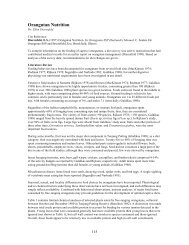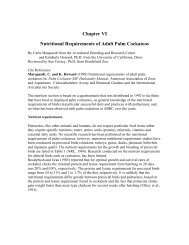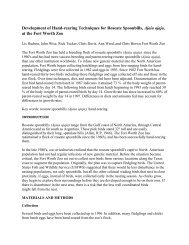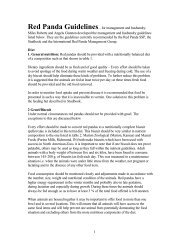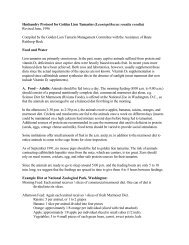AZA - Gibbons Fact Sheet
AZA - Gibbons Fact Sheet
AZA - Gibbons Fact Sheet
Create successful ePaper yourself
Turn your PDF publications into a flip-book with our unique Google optimized e-Paper software.
<strong>Gibbons</strong> <strong>Fact</strong> <strong>Sheet</strong> (5/1/94)<br />
<strong>Gibbons</strong> (Hylobates ssp.)<br />
Description: <strong>Gibbons</strong> are perhaps the most conspicuous animals in<br />
Southeast Asian rainforests. Their songs are described as some of the<br />
finest music ever uttered by a wild land mammal and their remarkable<br />
power and grace in swinging through their tall tree habitat is unparalleled.<br />
To many naturalists, gibbons are the voice and soul of the forest, an<br />
observation also held by indigenous peoples who have shared the same<br />
forests for centuries.<br />
Because of their small body size, gibbons are termed lesser apes. Their<br />
arms are relatively longer than their legs, adapting them to suspensory<br />
locomotion--or brachiation-- which allows rapid movement through the<br />
forest canopy and access to preferred foods. <strong>Gibbons</strong> come in many<br />
different combinations of color, including jet black, silvery, rufus or<br />
cinnamon; some species' colors vary with gender while other species<br />
change color as they mature.<br />
<strong>Gibbons</strong> in North American institutions are primarily represented by three<br />
species. The siamang (Hylobates syndactylus) is the largest and both<br />
sexes are all black but the male can be distinguished by a conspicuous<br />
inflatable throat sac used for loud vocalizations. The white-handed gibbon<br />
(H. lar) varies widely in appearance from area to area and can be either<br />
black or buff colored; it can be distinguished by its white hands and feet.<br />
The white-cheeked gibbon (H. concolor), also called the black gibbon, has<br />
black males sporting white or reddish cheek patches while females are<br />
buff or golden with black patches. Young change color as they mature<br />
(males once, females twice).<br />
Range: <strong>Gibbons</strong> are found throughout Southeast Asia from Assam in<br />
northeast India across Indochina, north into southern China and south<br />
throughout most of Indonesia. Specifically, the siamang is found on the<br />
Malaysian peninsula and Sumatra. The white-cheeked gibbon is found in<br />
Laos, Vietnam and southern China and the white-handed gibbon is found<br />
in Thailand, the Malaysian peninsula and the northern third of Sumatra.<br />
Habitat: <strong>Gibbons</strong> spend their entire lives in the tall trees of tropical<br />
rainforests.<br />
Diet: <strong>Gibbons</strong> are frugivores, feeding on small, but scattered fruits, young<br />
leaves and, with some species, a few invertebrates. Differences in diet
elate to differences in habitat and food availability. Otherwise, gibbon<br />
show a similar preference for fleshy, sugary fruit and figs.<br />
Social Organization: <strong>Gibbons</strong> are unique among apes, and even among<br />
Old World monkeys, in keeping strictly defended stable territories which<br />
they live within at all times. <strong>Gibbons</strong> also come close to the ideal of<br />
"mating for life." Each gibbon pair regularly advertises its territory by loud<br />
singing accompanied by spectacular gymnastics--a show of force. The<br />
female's great call dominates the half-hour morning bout of singing, and it<br />
is punctuated by the male's shorter phrases. These songs are consistent<br />
throughout the range for each species, but subtle differences characterize<br />
individuals. Territorial singing of the family broadcasts precise information<br />
on the species and sex of individuals, the area occupied by the parents<br />
and the presence of a sub-adult ready to form a new pair.<br />
Conservation Status: The IUCN Red List of Threatened Animals curently<br />
lists the Javan gibbon (H. moloch) and the Mentawai Islands gibbon (H.<br />
klossii) as endangered; the white-cheeked gibbon, the hoolock gibbon (H.<br />
hoolock) and the pileated gibbon (H. pileatus) are listed as vulnerable. The<br />
U.S. Fish & Wildlife Service lists all nine gibbon species as endangered<br />
and they are also under Appendix I protection of CITES. Most recently, the<br />
IUCN/CBSG Primate Working Group recognized 23 (possibly 26) subspecies<br />
among the nine species, placing the pileated, the Javan, the<br />
Mentawai Islands and all five white-cheeked subspecies as critical.<br />
Threats to Survival: Reduction of the tropical rainforest is the primary<br />
threat to gibbons. Poaching for food or capturing young gibbons for the pet<br />
trade is a secondary, but sometimes equally serious threat. The numbers<br />
of all gibbons in Asia have decreased rapidly in the past fifteen years.<br />
Zoo Programs - SSP: The <strong>Gibbons</strong> SSP is still under going planning and<br />
organization. At the inaugural meeting in 1990 the propagation group<br />
recommended the following plan based upon IUCN Priority Status and<br />
IUCN/Primate Specialist Group and IUCN/CBSG recommendations. a.)<br />
Because of their threatened or endangered status, the Javan, hoolock and<br />
Mentawi Islands gibbon species should be placed in captive breeding<br />
programs meeting necessary criteria, when sufficient numbers of<br />
individuals of each become available. (Possibly in North America or other<br />
regional programs.) b.) The agile (H. agilis) and the gray gibbon (H.<br />
muelleri) have a low priority for conservation and are not to be placed in a<br />
captive breeding program at this time. c.) Because the white-cheeked<br />
gibbon is endangered and a reasonable number of individuals are already<br />
held in North American facilities, expansion of its numbers through<br />
breeding has been recommended. d.) The pileated gibbon should be<br />
placed in a global breeding program, since it is endangered but only low<br />
numbers are held in North America. e.) The siamang and white-handed
gibbon have low conservation priority and their numbers in institutions are<br />
to be contained, allowing more space for other gibbon species. Also, there<br />
is to be a complete cessation of breeding until a molecular genetic<br />
analysis is performed.<br />
As of April 1995, there are about 150 siamangs, 50 white-cheeked<br />
gibbons and 230 white-handed gibbons in North American zoological<br />
facilities.<br />
Conservation: One on the Gibbon SSP's first tasks is to tackle some<br />
long-standing questions about the biological relevance of existing subspecies.<br />
To effectively design and implement appropriate management<br />
plans, the SSP must be able to recognize and divide gibbons into<br />
evolutionarily significant units. This will allow the SSP to take action to<br />
prevent undesirable hybridization between populations of different genetic<br />
make-up. A number of specific research questions have been identified,<br />
along with potential researchers capable of resolving these questions<br />
within one to two years.<br />
In situ conservation programs are not meeting the urgent need for action.<br />
Two species, the Javan and pileated gibbon, are listed as critical; yet, no<br />
conservation program exists for them, either for the Mentawai Islands<br />
gibbon on the southern most island of Pagai, west Sumatra, Indonesia;<br />
there are also plans to improve an established reserve on the northern<br />
island of Siberut. Another release back into forested areas depleted of<br />
gibbons is under discussion in Thailand.<br />
6/95<br />
©2000 American Zoo and Aquarium Association



